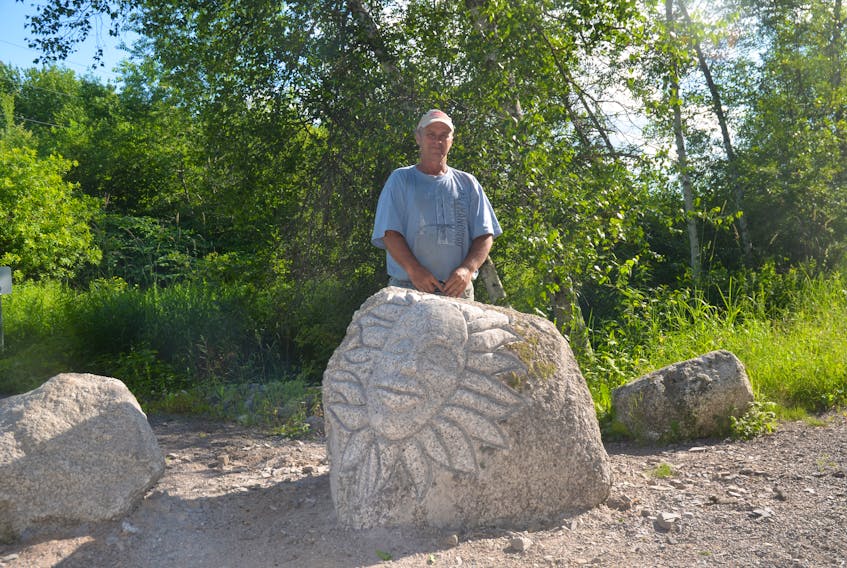BERWICK, N.S. — Something totemic sits quietly at intervals, marking the miles along trails in the lush wilderness of the Annapolis Valley.
Brent Reeve, an artist who admits he’s a pretty elusive person, has spent the last few years quietly roving about the wilderness in the Valley, choosing stones and carving them into mysterious works of art.
“They’re all over the place, from Waterville up to Aylesford and then out to Cloud Lake, and Tomahawk Lake and Shell Camp Lake,” Reeve said, describing how far and wide he has roamed finding places to leave his artwork.
About 100 of his carvings dot the landscape of the Valley. The carvings are as diverse as the places they can be found, with everything from bear prints and flowers to the likenesses of ducks and some very human visages peering out at the passersby from the grass.
“Some are symbols. Lake Tomahawk has a tomahawk on the rock, for example,” Reeve said. “It depends on where the rock is and who is going to be seeing it.”
The most accessible of all of Reeve’s carvings, however, are all along the tracks in the Town of Berwick.
People who stopped to admire his work while out on hike or a ride on an ATV or snowmobile, eventually started suggesting that Reeve take his ideas and start implementing them locally, so that more people could admire his work.
“A few people mentioned it’d be more accessible, so I did some in town,” Reeve said. “I approached Berwick’s public works department and they helped me get some rocks along the tracks.”
What inspires someone to go about the time-consuming task of carving intricate designs and faces into stone? Reeve said it started simply as a desire to get outside more.
“I had some health problems a few years ago and started carving. I’ve been carving objects since I was much younger. I didn’t take up rock carving until about five years ago and started carving rocks to get out of the house,” Reeve said. “I was a truck driver for many years and had to stop for health reasons. I got into carving and that helped me get out for some fresh air. It’s better than sitting at home watching TV.
The sculptures take a varying number of days to carve, he noted. Some can take as few as two days if they are simple enough.
Reeve works peacefully with far less of the droning or buzzing of power tools one would expect to hear when someone is making an impression in a rock. His tool kit for carving includes only four items: a chisel, a hammer, a grinder with a diamond blade and a generator to run the grinder.
His sculptures remain universal. He makes a conscious effort to carve sculptures that are apolitical and free of any sort of logo or symbol.
“I aim for stuff like dogs, or birds or flowers – something that is going to be relevant 500 to 600 years from now and nobody’s going to want to turn it over and hide it,” Reeve said. “You can go out for a walk and it doesn’t cost any money to go out and see those sorts of things.”
He emphasized what little planning goes into any of his carvings, noting they usually occur to him in the moment, while he’s looking at the rock he’s about to press his chisel against. Even when he tries to plan something in advance, he said spontaneity often takes over.
“I went out and decided to do a duck one day but ended up with a flower in a pot when I was done,” Reeve said. “Whatever the rock tells me in a situation, I do that. Sometimes it takes me twenty seconds to see what it is I’m going to carve; sometimes it takes hours of me sitting there, staring at it.”
The time he carved a flower pot, Reeve noted he later carved a duck when he felt it was more appropriate – beside a pond.
UNEXPECTED ATTENTION
One of the things that has surprised Reeve the most about his work is the amount of attention he gets for it.
“People talk to me about my work all the time and always thank me,” he said July 9. “It’s quite a shock.”
Reeve, who doesn’t own a computer and tries to avoid the internet, finds it amusing that he is posted all over social media, his work being the subject of a litany of internet conversations.
“I don’t do computers, and now I’m all over them,” he said with a chuckle.
Everyone who beholds his work is unanimously pleased with it, Reeve noted. That approval and happiness he can bring people serves as motivation to continue.
“It’s great. If some kid wants to sit on a rock and take a picture, I say, ‘go right ahead.’ I also realized this summer as a friend of mine was running their fingers over one of my carvings, that the visually impaired could benefit from these because you can actually walk up and feel them,” Reeve said. “I never thought of it until I said there watching a buddy feel one. I was pleased to have that aspect of it.”
Reeve, who originally hails from the Caledon area of Ontario, has lived all across Canada, once calling far-flung places like Grande Prairie, Alta. and Whistler, B.C. home. His parents retired to the Annapolis Valley and, through visiting them, the place grew on him.
“I thought, ‘I might as well just move here. Housing is affordable.’ It’s not so cheap, but it’s better than living off Kraft Dinner out west,” Reeve said.
He confirmed there are more carvings to come, adding there may be some stone shapes appearing in Annapolis Royal rather soon.
“We’ve been talking to the trails commission and hopefully we’ll work something out in Annapolis Royal,” Reeve said. “That’s a possibility.”









